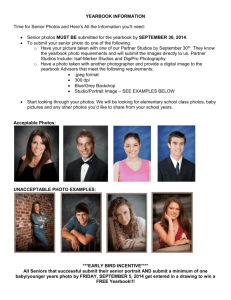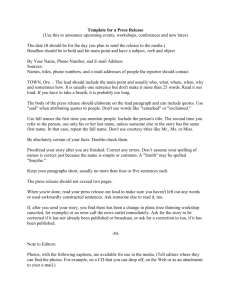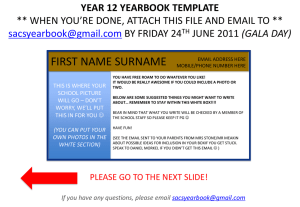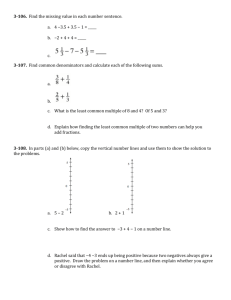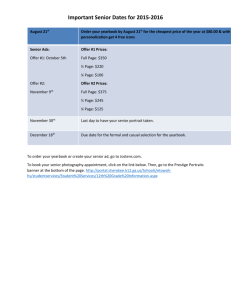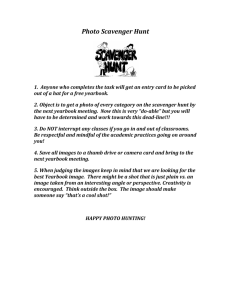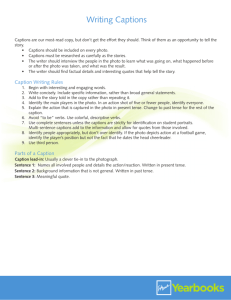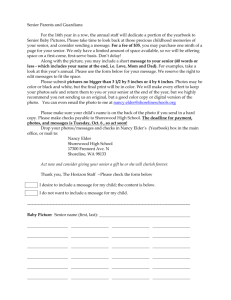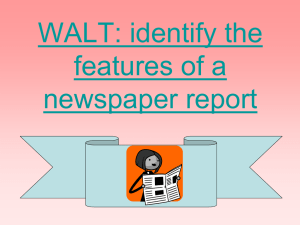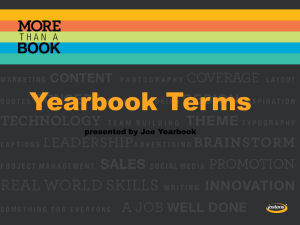Yearbook Pre-Test Choose the BEST or most accurate response for
advertisement
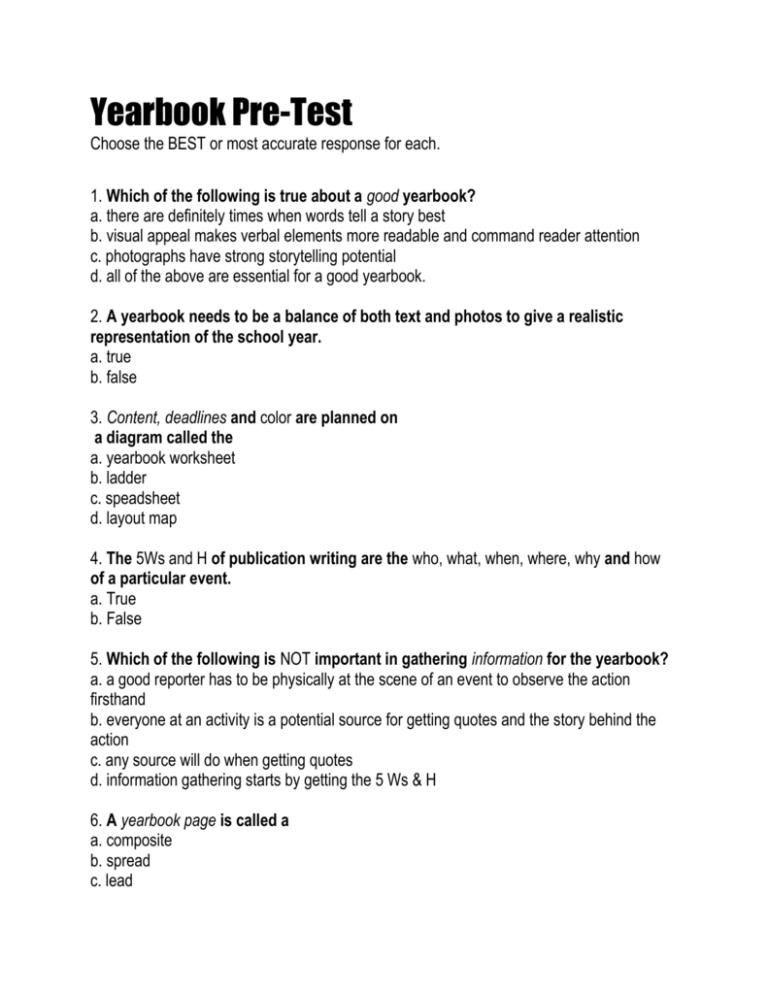
Yearbook Pre-Test Choose the BEST or most accurate response for each. 1. Which of the following is true about a good yearbook? a. there are definitely times when words tell a story best b. visual appeal makes verbal elements more readable and command reader attention c. photographs have strong storytelling potential d. all of the above are essential for a good yearbook. 2. A yearbook needs to be a balance of both text and photos to give a realistic representation of the school year. a. true b. false 3. Content, deadlines and color are planned on a diagram called the a. yearbook worksheet b. ladder c. speadsheet d. layout map 4. The 5Ws and H of publication writing are the who, what, when, where, why and how of a particular event. a. True b. False 5. Which of the following is NOT important in gathering information for the yearbook? a. a good reporter has to be physically at the scene of an event to observe the action firsthand b. everyone at an activity is a potential source for getting quotes and the story behind the action c. any source will do when getting quotes d. information gathering starts by getting the 5 Ws & H 6. A yearbook page is called a a. composite b. spread c. lead d. design 7. Effective yearbook writing shares which of the following traits of all good writing? a. starts with solid substance b. clearly-written and lively c. utilizes narrative elements d. is fresh and original e. all of the above 8. Yearbook copy should focus on the events themselves, not on how the readers will want to remember the events. a. True b. False 9. When collecting information about a person or event. a reporter should a. have a plan---know what it is you want to find out b. go to the primary sources---people in the photo, coach, teacher, etc. c. have questions pre-planned and pre-checked by the adviser d. be sure the info collected is meaningful---if not, go back to the source for more or approach a different source c. a reporter should do all of the above 10. YES and NO questioning usually produces the best responses from people because it's fast and simple. a. True b. False 11. When collecting data, a reporter must take into account everything that took place for a sport of club throughout the season, then zero-in on a particular event that people are most likely to remember. a. True b. False 12. Well-written copy should a. capture a moment, not relate everything single detail that took place over an extended period of time b. appeal to the reader's emotions c. paint a picture through creative and descriptive word choice d. all of the above are necessary for good copy 13. Which of the following is NOT crucial to good copy? a. a strong lead sentence captures the reader's attention and draws them into the story b. focus on facts the readers don't already know---for example “a day in the life” or “ behind the scenes” c. list as many people as possible to remind them they were part of the event d. give an example, describe a scene, weave a story---do something other than just tell 14. Which of the following is NOT true about the impact of headlines on a yearbook spread? a. written properly, headlines draw readers into the storytelling b. with impact words and specific facts, a headline contributes to the reporting c. a carefully written headline can take the place of body text and captions d. the mix of primary and secondary headline patterns add interest and eye-appeal 15. A well-written headline should always contain an active verb. a. True b. False 16. A sub-head, or secondary headline, a. is merely a heading or title of the team, club or organization b. gives more information about the subject of the spread c. lists all the people featured on the page d. always appears in bold caps 17. A caption's content combines with a photograph to tell a story. Which of the following is TRUE about successful caption writing? a. captions should do more than state the obvious b. captions answer readers' questions about a photo c. caption writing requires good reporting d. quotes from an individual in the photo adds depth e. all of the above are true 18. Captions summarize the 5 Ws & H, but shouldn't tell the reader what is already obvious in the photo. a. True b. False 19. Reporters often get hung-up on one sentence caption writing. Instead, a reporter should try for 2 sentences without repeating info already stated in the headline or body copy, followed by a strong quote from someone in the photo. a. True b. False 20. Which of the following should a reporter be aware of when writing captions? a. captions are always written in past-tense form b. don't add your own opinion c. identify everybody---if you can see their faces clearly, name them (except in team photos or large group shots) d. never assume---check and double check the facts e. all of the above are important to be aware of when writing captions 21. A caption head is like a mini-headline and should contain an attention-grabbing verb. a. True b. False 22. Which of the following is the correct set-up format for a caption? a. caption, caption head, quote b. quote, caption head, caption c. caption head, quote, caption d. caption head, caption, quote 23. What is wrong with the following copy or caption sentences? A good time was had by all. The half-time show was a huge hit! Billy-Bob and Sally-Sue were looking to the future with hope. a. these are generalizations and assumptions made by the reporter without any facts to back them up b. they don't contain any substantial information c. nothing--- as long as they are followed by a good quote d. choices a & b both reflect the problem with these statements 24. The team looks forward to a great season. Why is this a poorly written statement? a. it doesn't make sense---when would a team NOT look forward to a great season? b. the term 'great' is vague---it can mean different things to different people. c. it's written in present tense d. all of the above make it a poorly written statement 25. A yearbook reporter uses good questioning techniques to help focus the story. If the information collected seems incomplete and the quotes uninformative, it means the reporter--a. should ask someone else on staff to cover their page b. is not done collection information---go back and either re-interview or interview others c. should go with what she/he has because there is a deadline to meet d. should alter poorly stated quotes so they sound good 26. ] Being crowned Homecoming king and queen were Kwaneesha's and Tyrone's moment to shine. This type of statement should be avoided because it doesn't say anything of importance. a. True b. False 27. Which of the following is important to remember when using quotes in copy and captions? a. be sure what the person said is not offensive or untrue b. a reporter can only alter a quote to make it grammatically correct c. quotes are always written in the quote first, attribution second order d. the words within the quotation marks ends with a comma e. all of the above are important to remember 28. Why are the following poor examples of quotes? “Prom was so awesome!” said Kitty Tallywhacker '19. “I really had fun this year,” said Tiffy Tuffington '15. “We were close like family,” said Voneesha Sparks '16. a. awesome, great, fun and similar words are so over-used that they've become meaningless b. nothing in the quotes further clarifies what's happening in the photo c. quotes should add depth to the story or caption, not just act as filler d. all are reasons why quotes like these should not find their way into the yearbook 29. When identifying a person, state both first and last name on the first reference, and then only the last name on further references. a. True b. False 30. Which of the following is the correct format for a quote? a. Senior Mary McMuffin said, “blah, blah, blah.” “blah, blah, blah.” said senior Mary McMuffin. “blah, blah, blah,” Mary McMuffin '16 said. “blah, blah, blah,” said Mary McMuffin '16. 31. Terms like Mr., Mrs., Ms. and Miss are not standard usage in a publication. Always list the position (principal/teacher/coach) followed by their first and last name. a. True b. False 32. Yearbooks depend on good photos to tell the story of the year. Which of the following should a photographer remember when taking pictures for a spread? a. good photos show action and energy b. the more photos taken, the greater likelihood of having an assortment of good photos to choose from c. angles and positions of photo subjects should be varied d. the photo is not over-crowded or cluttered ---unless it is a crowd shot e. all are important to remember for quality photos 33. Viewers shouldn't have their eyes pulled in 3 or 4 different directions---there should be one main subject. a. True b. False 34. With a few exceptions, like mock elections or a team photo, pictures should NOT be posed. a. True b. False 35. A good spread has a balance of vertical and horizontal shots. a. True b. False 36. For sports shots a. it's crucial to attend more than one game b. take photos during practices for good close-ups c. pre-arrange with the coach to allow you on the court or field d. never shoot through a fence e. all are equally important to remember 37. When it comes to taking sports or club shots, it's important to wait until the end of the season to take photos because that's when clubs are most active and sports teams are most spirited. a. True b. False 38. The Rule of Thirds involves a. dividing your photos into thirds---best, okay and poor b. positioning your subject slightly off center instead of directly in the center of the photo c. try to have 3 subjects in the photo equally spaced d. counting to 3 before snapping the photo to assure a good shot 39. This photo shows what photography technique? a. depth of field b. focusing c. the Rule of Thirds d. digital imaging 40. In this photo, the rope--a. is distracting, taking away from the human element b. acts as a leading line---directing the viewer's eyes to the main subject c. poses a danger to teens and should not be featured in the yearbook 41. Why is this a good photo? It--a. focuses on minorities in an all-white school, showing balance b. shows that even losers are winners in the game of life c. shows not all the drama is on the court or field—it can also be found on the sidelines 42. What should a photographer do if the photos are blurry, posed, too far away or generally poor quality? a. take more photos asap b. check with adviser that the camera is functioning properly c. review photography techniques to avoid another batch of poor photos d. a responsible photographer should do all of the above 43. Before a spread can be considered complete, a reporter needs to do ALL but which of the following? a. double check and triple check the spelling of all names with a master list b. be sure all facts are correct and quotes are meaningful c. make sure spelling, grammar, punctuation and sentence structure are correct d. be sure all captions are in the proper format e. submit a page even if it's incomplete so a deadline is met 44. The publication of the school yearbook is a legitimate business and its existence depends heavily on advertising dollars. It's important--a. that every staff member participates and does his/her best to achieve the dollar goal b. the staff works as a team, helping each other achieve their goals collectively c. to be professional when dealing with businesses in person or by phone d. to be vocal and get help if needed e. all of the above are equally important 45. Some staff members fail to realize that NOT reaching the advertising goal can result in a. a reduction or removal of color b. a smaller book---in number of pages and page size c. a plain uninspiring cover d. no yearbook at all e. all the above 46. Which of the following is the BEST way to approach selling ad space? a. by phone since people usually don't like teens entering their work space b. in person---the human element of putting a name with a face c. by email or texting because electronic communication is what's hot 47. After trying the assigned ad prospects, a staff member can also a. try businesses in nearby communities b. get contact information of corporate offices of major stores c. check with places of employment of family, friends, neighbors d. scan the phone book yellow pages or a listing of area businesses and check with the business editor that the place has not already been approached by another staffer e. a responsible staffer should attempt all of the above 48. When selling ad space, which of the following introductory lines has the GREATEST chance of proving successful? a. ''You wouldn't want to buy an ad, would you?' b. “Hi, iIm from—-and we were hoping you'd help support (or continue to support) our publication by running an ad for your business this year...” c. “Hi, I'm from—- and I'd like to know if you'd like to buy an ad.” d. “Hi. Gimme yer money.” 49. Yearbook style reminders can be found a. on the internet---just google yearbook style b. in the yearbook styleguide and on the board above the computers c. by asking the editor(s) or adviser for the information 50. It is the responsibility of the yearbook staffer to go though the page checklist and make any corrections/alterations before submitting the page to the editor(s). a. True b. False 51. When a person's page is complete and has been given the OK by the editors and adviser, a staffer should ALL but which of the following? a. read/scan through the entire page again, looking for errors b. ask the editor for a copy of other completed pages to proofread c. offer to help those who are behind laying out their page d. take some “me time” by playing internet games, texting, visiting Youtube or roaming the halls 52. What is the proper procedure for the staff cameras and equipment? a. care should be taken in their handling---cameras are expensive b. cameras should be returned to the adviser the following day c. both memory cards and card readers need to be returned to the adviser---not left by the computers or a desk d. all should be followed
